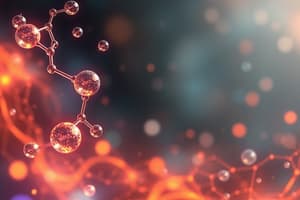Podcast
Questions and Answers
The science of organic chemistry primarily studies the relationship between what two aspects?
The science of organic chemistry primarily studies the relationship between what two aspects?
- Molecular structure and properties (correct)
- Isomerism and physical state
- Molecular mass and reaction rates
- Atomic number and electron configuration
Silicon is capable of forming strong covalent bonds with itself, leading to similar diversity in compounds as carbon.
Silicon is capable of forming strong covalent bonds with itself, leading to similar diversity in compounds as carbon.
False (B)
What is the term for molecules with the same molecular formula but different structural arrangements?
What is the term for molecules with the same molecular formula but different structural arrangements?
isomers
Organic compounds are generally ______ and/or sensitive to heat.
Organic compounds are generally ______ and/or sensitive to heat.
Match the following bond types with the number of shared electron pairs:
Match the following bond types with the number of shared electron pairs:
What is the valence of carbon, and what does this mean?
What is the valence of carbon, and what does this mean?
Structural isomers have different molecular formulas but the same structural formulas.
Structural isomers have different molecular formulas but the same structural formulas.
What two central premises form the foundation of structural theory in organic chemistry?
What two central premises form the foundation of structural theory in organic chemistry?
Electrons in the outermost shell of an atom are called ______ electrons.
Electrons in the outermost shell of an atom are called ______ electrons.
Match the following:
Match the following:
According to the Lewis scheme, how do atoms achieve a completed valence shell?
According to the Lewis scheme, how do atoms achieve a completed valence shell?
Ionization energy is the energy released when an electron is added to an isolated atom.
Ionization energy is the energy released when an electron is added to an isolated atom.
What type of elements generally form ionic bonds, and why?
What type of elements generally form ionic bonds, and why?
In Lewis Structures, a covalent bond can be represented by a pair of ______ or a short line between bonded atoms.
In Lewis Structures, a covalent bond can be represented by a pair of ______ or a short line between bonded atoms.
Match elements with the number of covalent bonds they typically form based on valence electrons:
Match elements with the number of covalent bonds they typically form based on valence electrons:
What is the correct formula to calculate formal charge on an atom in a Lewis structure?
What is the correct formula to calculate formal charge on an atom in a Lewis structure?
A carbon atom with three covalent bonds and one lone pair is neutral.
A carbon atom with three covalent bonds and one lone pair is neutral.
What are the two main groups of organic compounds?
What are the two main groups of organic compounds?
Elements other than carbon and hydrogen in an organic compound are called ______.
Elements other than carbon and hydrogen in an organic compound are called ______.
What defines the structure and determines the properties of a class of organic compounds?
What defines the structure and determines the properties of a class of organic compounds?
Flashcards
Organic Chemistry
Organic Chemistry
The study of carbon-containing compounds and their properties.
Valence
Valence
The capacity of an atom to form a fixed number of chemical bonds.
Lewis Scheme
Lewis Scheme
Atoms bond so that each atom acquires a completed valence shell configuration.
Ionic Bond
Ionic Bond
Signup and view all the flashcards
Covalent bond
Covalent bond
Signup and view all the flashcards
Lewis Structure
Lewis Structure
Signup and view all the flashcards
Formal Charge
Formal Charge
Signup and view all the flashcards
Heteroatoms
Heteroatoms
Signup and view all the flashcards
Hydrocarbons
Hydrocarbons
Signup and view all the flashcards
Functional Group
Functional Group
Signup and view all the flashcards
Alkynes
Alkynes
Signup and view all the flashcards
Aryl Halides
Aryl Halides
Signup and view all the flashcards
Alkanes
Alkanes
Signup and view all the flashcards
Alkenes
Alkenes
Signup and view all the flashcards
Study Notes
- Organic chemistry studies the relationship between molecular structure and properties
- Study of organic chemistry should start with the common structural features of organic compounds
- Need to review chemical ideas, especially related to atomic structure and bonding for a better understanding of molecular structures
- Organic compound classes are examined, aiming to enhance understanding in further studies
Module Objectives
- Recognize the vast number and structural diversity of organic compounds
- Accurately draw Lewis structures
- Identify and classify functional groups in organic compounds
Pre-Competency Assessment
- Organic Chemistry studies carbon-containing compounds
- Organic compounds primarily have covalent bonds
- Priestly disproved the vital force theory
- Carbon (atomic number 6) has 4 valence electrons
- Functional groups are the most reactive parts of organic compounds
The Nature of Organic Compounds
- Kekulé and Couper determined carbon is tetravalent, forming four bonds with other atoms (H, O, N, and C)
- A key feature of carbon atoms is their ability to form strong covalent bonds with each other
- Carbon atoms can link to form linear, branched, or cyclic backbones in organic molecules
Isomerism
- Isomerism is exhibited by Organic molecules
- The term "isomerism" is derived from the Latin "iso" (equal) and "mer" (part)
- Structural isomerism: same molecular formula, different structural formulas
- Stereoisomerism: same molecular and structural formulas, different three-dimensional structures (stereos - solid)
Behavior of Organic Compounds
- Organic compounds, largely covalent, typically have low melting points and limited water solubility
- Some organic compounds are gases, others are liquids at room temperature, and solids usually melt below 400 °C
- Ionic inorganic salts have melting points above 1000 °C and dissolve readily in water
Physical Properties of Organic Compounds
- Primarily combustible (flammable) and/or sensitive to heat (decompose when heated)
- Sucrose isn't combustible but sensitive to heat, decomposes to carbon
- Organic chemistry is an empirical science based on laboratory observations
- August Kekulé, Archibald Scott Couper, and Alexander M. Butlerov developed the structural theory (1858-1861)
- Atoms in organic molecules form a fixed number of bonds (valence)
- Carbon atoms can participate in single, double, and triple bonds
Electronic Structure and Bonding
- Electrons in the outermost shell of an element are involved in chemical bonds and reactions
- Valence electrons exist in the valence shell, the energy level of outermost shell electrons
- Lewis structures use atomic symbols surrounded by dots to show the number of valence electrons
Formation of Chemical Bonds
- Gilbert N. Lewis noted noble gases' chemical inertness indicates stable electron configurations
- Atoms bond to achieve a completed valence shell electronic configuration
- Atoms acquire completely filled valence shells by gaining/losing electrons (ionic bond) or sharing electrons (covalent bond)
- Ionic bonds form when atoms transfer electrons
- Atoms with low ionization energy (IE) lose electrons easily
- Ionization energy (IE) is needed to remove the most loosely held electron from an isolated atom in its ground state
- Atoms with high electron affinity (EA) gain electrons easily
- Electron affinity (EA) is the energy released when adding an electron to an isolated atom in its ground state
- Electron affinity generally increases across the periodic table
Covalent Bonds
- Formed through the sharing of electrons by two atoms
- Atoms obtain a noble gas electron configuration
- Atoms in the middle of the periodic table share electrons due to the energy needed to gain/lose electrons
Lewis Structures
- Show covalent bonds as a pair of dots between bonded atoms
- Shorthand notation represents shared electrons as a dash or line -Unshared electron pairs (lone pairs) are shown as a pair of dots
- An atom forms as many covalent bonds with other atoms as needed to fill its valence shell
- Carbon forms four covalent bonds, nitrogen forms three, oxygen forms two, and halogens form one
Writing Lewis Structures
- Used for representing electronic structures of atoms, ions, and molecules
- Provide an accurate accounting of electrons
- A correct Lewis structure needs:
- Valence shell electrons assigned correctly
- Formal charges assigned correctly Sometimes covalently bonded atoms have a charge called formal charge
Classification of Organic Compounds
- Organic compounds are divided into hydrocarbons and heteroatom-containing compounds
- Hydrocarbons contain only carbon and hydrogen
- Elements other than carbon and hydrogen in organic compounds are heteroatoms
- Hydrocarbons are aliphatic or aromatic, with aliphatics including alkanes, alkenes, alkynes, and cyclic analogs
- Heteroatoms present include organic halides (halogens), alcohols/phenols/ethers/aldehydes/ketones/carboxylic acids/anhydrides/esters (oxygens), amines (nitrogen), acid halides (oxygen & halogen), amides/amino acids (oxygen & nitrogen), and thiols/sulfides (sulfur)
Functional Groups
- Classifies organic compounds by structure
- Functional group: the atom or group of atoms that defines the structure and properties of a class
- The behavior of a functional group is nearly the same whether in a small, big, or complex molecule
- Organic chemistry is largely functional group chemistry
- Functional groups have similar physical and chemical properties
- Studying a few compounds as representatives can characterize thousands more
- Familiarizing functional groups is a good way to start learning organic chemistry
Studying That Suits You
Use AI to generate personalized quizzes and flashcards to suit your learning preferences.




